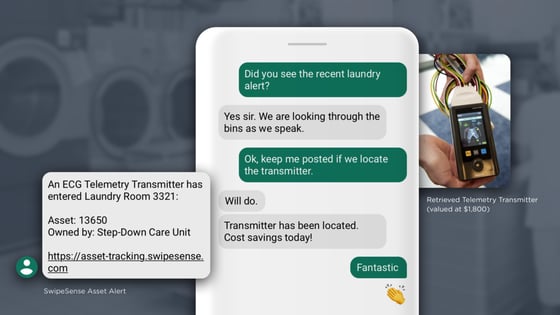 One of the first questions hospitals ask us is “what is the impact of your system”. This in fact should be the question everyone asks before investing in a technology. For SwipeSense, case studies are a great way to show how our customers are seeing the impact of SwipeSense. With the recent launch of Asset Tracking many hospitals may be wondering how the system works, and what impact they can expect if they were to implement the solution.
One of the first questions hospitals ask us is “what is the impact of your system”. This in fact should be the question everyone asks before investing in a technology. For SwipeSense, case studies are a great way to show how our customers are seeing the impact of SwipeSense. With the recent launch of Asset Tracking many hospitals may be wondering how the system works, and what impact they can expect if they were to implement the solution.
HOW DOES ASSET TRACKING WORK?
The SwipeSense system assigns a Real-Time Location System (RTLS) tag to each moving asset within the hospital. Hospitals have chosen to tag everything from wheelchairs to IV pumps to telemetry modules - pretty much anything that moves throughout the hospital. The asset tags communicate with a network of outlet-powered Location Hubs to locate tagged assets down to room-level accuracy all throughout the hospital.
WHY DOES IT MATTER?
Hospitals care about this because lost or stolen equipment costs an average hospital over $1M every year. One major problem tends to be equipment getting thrown in with the laundry when EVS gathers the bed sheets, and before you know it that expensive telemetry module is being laundered.
ASSET TRACKING IN ACTION
Accidental laundering of a device almost happened to one of our customers last weekend, if not for the alert sent out by the SwipeSense Asset Tracking System. SwipeSense notified hospital staff that the module had entered a non-designated zone, and within minutes they went through the exact laundry basket and recovered the expensive piece of equipment before any damage was done.

The alerts feature of Asset Tracking works by selecting which tagged assets need to be monitored paired with what areas they are allowed. From here the alert can be set to notify any member on the team by text or email whenever that item enters a non-designated area. Having instant notifications is key to getting the most out of an asset management platform.
If you are like other hospitals that are losing thousands of dollars in equipment, then we invite you to request a demo and learn more about how our sensor network can track your devices too!


